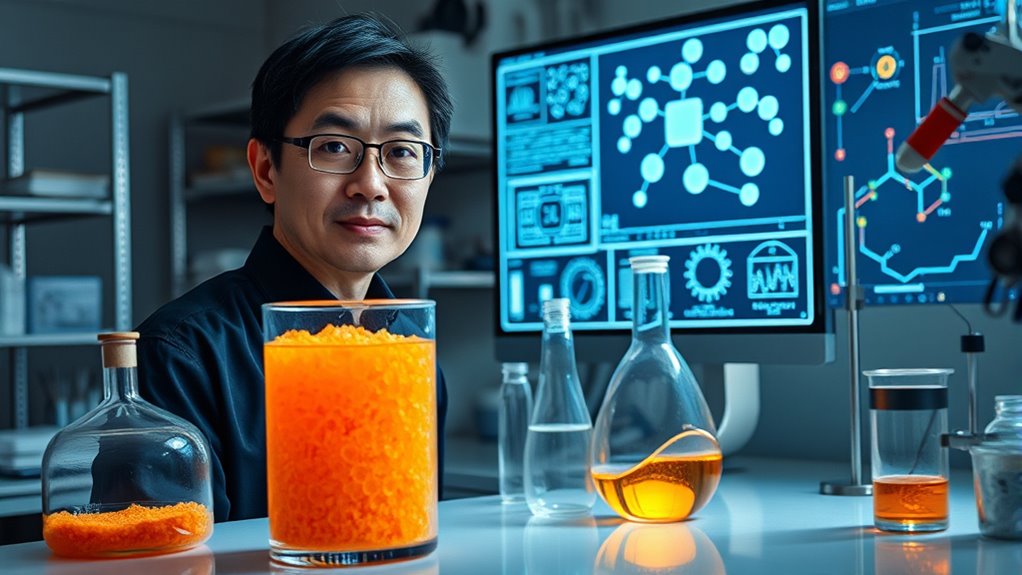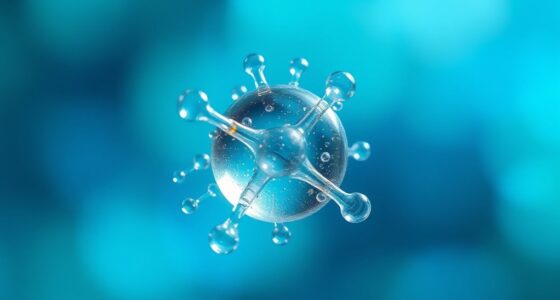Akira Yoshino’s pioneering work in developing the lithium-ion battery revolutionized how you generate, store, and use energy every day. His innovation laid the foundation for portable devices, electric vehicles, and renewable energy integration. By creating a safe, high-capacity rechargeable battery, he transformed modern technology and energy sustainability. If you want to discover how his contributions continue to shape our future, there’s much more to explore about this powerful breakthrough.
Key Takeaways
- Akira Yoshino developed the layered carbon-based anode crucial for the safety and rechargeability of lithium-ion batteries.
- His innovations in battery chemistry laid the foundation for portable electronics and electric vehicles.
- Yoshino’s work enabled the high energy density and long cycle life that transformed energy storage technology.
- His contributions have driven ongoing advancements in battery materials, safety, and charging speed.
- Yoshino’s pioneering research has significantly impacted renewable energy storage and global efforts toward sustainable technology.

Have you ever wondered what’s driving the global shift toward cleaner energy and portable technology? The answer lies in groundbreaking advancements in battery innovation, particularly the development of lithium-ion batteries. These batteries have transformed how we store and use energy, powering everything from smartphones to electric vehicles. Their success hinges on their ability to provide high energy density, long cycle life, and safety, making energy storage more efficient and reliable than ever before.
At the heart of this revolution is Akira Yoshino, whose pioneering work in the 1980s laid the foundation for modern lithium-ion technology. Imagine being the scientist who, after years of experimentation, discovers a way to replace bulky, less efficient batteries with lightweight, rechargeable ones. Yoshino’s innovation involved creating a layered structure with a carbon-based anode and a lithium cobalt oxide cathode. This design allowed for the safe and repeated charging and discharging of batteries, a feat that was previously elusive. His work didn’t just improve battery performance; it revolutionized energy storage itself, enabling portable devices to become smaller, more powerful, and more accessible.
Akira Yoshino’s breakthrough in layered lithium-ion batteries transformed portable energy storage and device innovation.
You might not realize it, but every time you charge your smartphone or electric car, you’re benefiting from Yoshino’s breakthrough in battery technology. His contributions made it possible to store larger amounts of energy in a compact form, which is essential for expanding renewable energy sources like solar and wind. Without efficient energy storage, integrating these intermittent power sources into the grid would be nearly impossible. Thanks to innovations inspired by Yoshino’s work, batteries can now hold energy for hours or even days, smoothing out supply and demand, and making renewable energy more viable on a large scale. Additionally, research continues to improve the energy density and safety features of lithium-ion batteries, ensuring their relevance for future technological advancements.
Moreover, the ongoing evolution in battery innovation continues to push the boundaries of energy storage. Researchers are exploring new materials and designs to increase capacity, reduce charging times, and improve safety. These advances are indispensable for supporting the global transition to electric vehicles and renewable energy systems. As you use modern electronics and support cleaner energy initiatives, you’re indirectly part of this ongoing revolution—a movement rooted in Yoshino’s initial discoveries that have made portable, sustainable energy storage a reality.
In essence, the lithium-ion revolution, driven by Akira Yoshino’s pioneering work, has dramatically changed how we think about energy. It’s no longer just about generating power but storing it efficiently and safely. This shift is essential for tackling climate change, advancing technology, and creating a more sustainable future for everyone.
Frequently Asked Questions
How Did Akira Yoshino’s Early Research Influence the Lithium-Ion Battery Development?
Your understanding of Akira Yoshino’s early research shows how he focused on electrode materials and electrolyte stability. By experimenting with different materials, he improved the battery’s capacity and safety. His work led to the development of a lightweight, rechargeable lithium-ion battery that is now used worldwide. You can see how his insights into electrode chemistry and electrolyte behavior directly influenced the efficiency and commercial viability of modern lithium-ion batteries.
What Are the Current Challenges in Lithium-Ion Battery Recycling?
Imagine your battery’s life as a story, but now, the ending is uncertain. You face challenges like battery degradation and low recycling efficiency, which hinder sustainable reuse. The complex materials make recycling difficult, and harmful waste piles up. To turn the page, you need advanced methods that improve recycling processes, recover more materials, and reduce environmental impact. Only then can we truly give lithium-ion batteries a second chance.
How Do Lithium-Ion Batteries Compare to Emerging Energy Storage Technologies?
You’ll find that lithium-ion batteries currently dominate due to their high energy density and widespread use. However, emerging technologies like solid-state batteries promise greater safety and longer life, while flow batteries offer scalable, long-duration energy storage ideal for grid stability. These alternatives may surpass lithium-ion in specific applications, but they still face challenges like cost and commercialization, making lithium-ion batteries a reliable choice for now.
What Environmental Impacts Are Associated With Lithium Mining for Batteries?
Oh, the glamorous world of lithium mining—where environmental concerns take a backseat! You should know that mining practices often cause habitat destruction, water pollution, and high energy consumption. These practices can lead to soil degradation and harm local communities. While lithium is essential for batteries, its extraction leaves a hefty environmental footprint, making you wonder if the pursuit of clean energy isn’t just shifting pollution from one place to another.
How Might Future Innovations Improve Lithium-Ion Battery Safety and Performance?
Future innovations could greatly improve lithium-ion battery safety and performance through solid state advancements and better thermal management. You’ll see safer batteries with solid electrolytes that reduce fire risks and enhance stability. Additionally, improved thermal management systems will keep batteries cooler, preventing overheating and extending lifespan. These developments make batteries more reliable, faster charging, and longer-lasting, helping you enjoy safer, more efficient energy storage for electric vehicles, gadgets, and renewable energy systems.
Conclusion
Just as Prometheus ignited fire for mankind, Akira Yoshino sparked the lithium-ion revolution, transforming how we power our lives. His innovations have lit the way toward a sustainable future, where energy flows seamlessly and endlessly, much like the eternal flame. Remember, every device you rely on today owes a debt to his pioneering spirit. As you move forward, carry the torch of progress, inspired by a true legend who changed the course of history with a simple, yet revolutionary idea.









